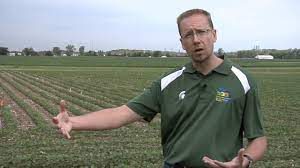Starting Right to Finish Well
By Dusty Sonnenberg, CCA, Ohio Field Leader: a project of the Ohio Soybean Council and soybean checkoff.
Is there a place for using a starter fertilizer when planting soybeans? Farmers often think of using starter fertilizers when planting corn for various reasons. These can include: giving roots early access to plant nutrients, to stimulate early plant growth, to improve stand uniformity, to add micronutrients, and hopefully to increase yield.
Dr. Kurt Steinke, Associate Professor, Soil Fertility and Nutrient Management Specialist for Michigan State University Extension has looked at research conducted when using starter fertilizer applied as a 2×2 when planting soybeans in 30 inch rows. “The first thing to consider when thinking about using a starter fertilizer on soybeans, it what are your soil test concentrations,” said Steinke. “What are the P and K levels. If the K levels are not deficient, then a farmer can probably go without K in the starter.”

Corn starter typically contains nitrogen, phosphorus, and possibly a micronutrient like sulfur. “You should consider how the N and P levels are in the soil test, and possibly micronutrients like S,” said Steinke. “Typically, we try to keep our starter for soybeans around 20 units of N. The reason is that if a starter exceeds 20 units of N, we have observed a decrease in nodulation. It does not make any sense to apply more N if you are going to reduce nodulation.”
Steinke has not seen consistent response to sulfur in the starter. “We haven’t seen great sulfur responses in soybeans,” said Steinke. “Typically sulfur response is seen in crops like corn and wheat.”
Steinke cautions that the use of a starter in beans should be reserved for high yielding environments. Using too much starter, or if it is used in the wrong environment can increase the risk for white mold. “High yield may be defined as 70 bushels per acre,” said Steinke. “Often, we see a beneficial response in high yield environments, and irrigated fields. The thing that farmers need to watch for is the risk of white mold and the yield losses. We have observed yield losses in high yield environments from white mold as high as 20 bushels per acre. In those high yield environments with 30 inch rows and starter fertilizer we had row closure before the solid drilled beans, and the white mold wiped out about 20-25 bushels per acre. In some treatments, the healthy beans yielded 95 bushels per acre, and the beans with the white mold yielded 75 bushels per acre.”
Can starter fertilizer be beneficial to soybeans. The answer is it depends. “A little bit of starter may be good. A little more may not be. Take a look at the soil test levels, and plan accordingly,” said Steinke.